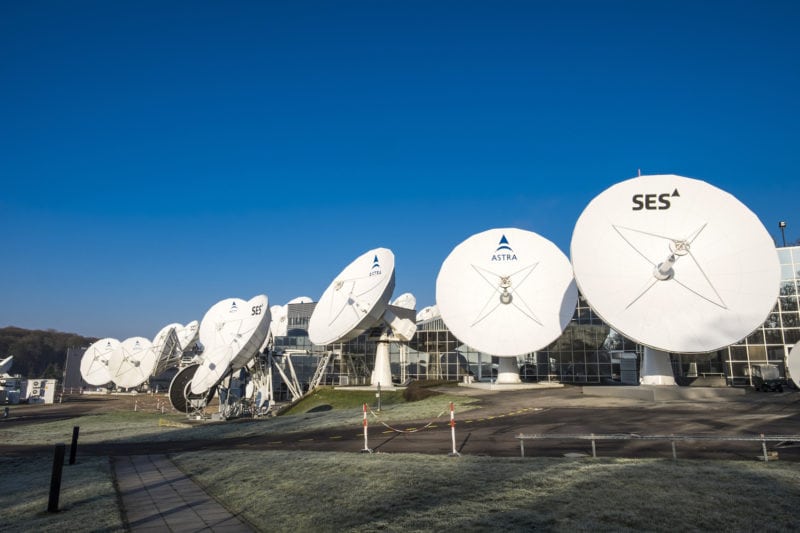Latest News

SES antennas at the satellite operator’s headquarters in Luxembourg. Photo Credit: SES
When SES released its latest results last week, it contained few surprises. The Networks business continued to perform well, but Video remains a struggle for the operator. However, an important question for SES in 2019 will be whether or not the C-Band Alliance (CBA) can maintain vital C-Band spectrum. In a report issued yesterday ironically titled Pray for C-band, Sarah Simon, a satellite equity analyst at Berenberg, said that SES had met expectations for 2018. “Organic growth was 1.7 percent, reflecting strong growth in the Networks division (plus 15.8 percent underlying), which more than offset weakness in Video (minus 4 percent underlying, with Distribution down 5.2 percent and Services minus 0.5 percent),” she said. “Progressive deterioration in Video has prompted a more cautious outlook, with management cutting 2020 group revenue guidance from 2.11 billion euros minus 2.21 billion to 2.06 billion euros minus 2.16 billion euros.”
Simon said that Berenberg is slightly below the bottom of guidance, and while the mid-point of the EBITDA guidance represents a 5.5 percent reduction, Berenberg sees fair value as declining by more, given the mix change in favor of data. “This is because we think data merits a lower multiple than video, given shorter contract duration and greater risk of capex obsolescence. For now, shares are not reflecting this, given high hopes for C-band. We must therefore hope that the CBA succeeds in monetizing the spectrum, as SES shares would be lower if the market were not pricing in upside in this regard,” added Simon.
While Simon called SES’ Video performance “disappointing”, she highlighted the strong performance of its Networks business — which, she believed exceeded expectations by calling its performance strong. “While video disappointed, all three units within Networks delivered growth — even fixed networks, which was still in negative territory in H1,” she added. “Granted there were some one-off project revenues that may not recur, but even so the performance of the overall Networks business was strong. Government up 19 percent, Fixed networks up 2 percent and Mobility up 35 percent reflects the bringing into service of SES-14, GovSat-1, and another four O3b satellites. 2019 will see SES benefit from SES-12, which recently entered service, and from another four O3b satellites, for which launch is scheduled at the end of this month. We are consequently comfortable with guidance for Networks in 2019 and 2020.”
Simon, however, wasn’t optimistic about the Video business and believed the decline could be even more than SES expects. “Meanwhile, SES’ guidance of a 2 percent decline in video in 2020 looks optimistic given current underlying trends: we think there is a risk of further cuts to this guidance.”
Giles Thorne, a satellite equity analyst at Jefferies, has also put out a research note, which he described 2018 as a breakout year for SES Networks. “SES outperformed 4Q18 expectations (plus 4.4 percent ahead on revenue, plus 1.1 percent ahead on EBITDA) and its own FY18 guidance. Within the mix, the Networks performance was impressive (plus 12.2 percent ahead of consensus), the Video performance more muted (minus 0.4 percent behind). Group revenue growth (constant FX, lfl) accelerated to plus 5.2 percent from plus 2.4 percent / plus 4.0 percent in 3Q18 / 2Q18 – on the more meaningful underlying revenue perimeter, we also note improvement (plus 1.9 percent from plus 1.6 percent / plus 3.2 percent). The strong finish to 2018, and the Networks contribution therein has undoubtedly given management a spring in their step; Video refuses to toe the line,” he said.
Get the latest Via Satellite news!
Subscribe Now